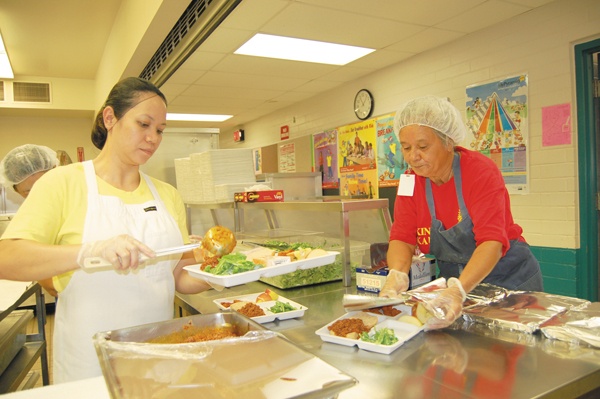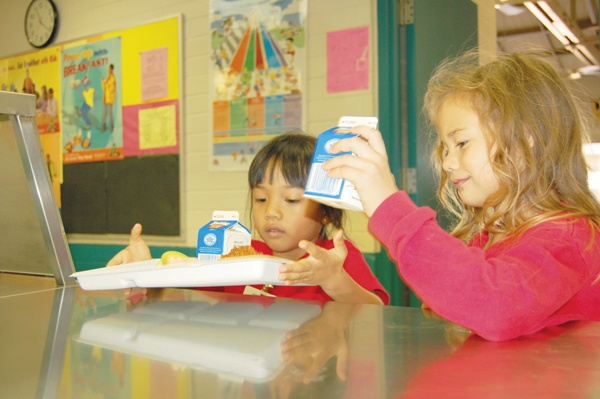A bite of knowledge


HANAMAULU — It is 7:50 on Monday morning and the school week is just beginning for the nearly 620 students at King Kaumualii Elementary School.
The day, however, is already half way done for those in the school’s cafeteria, where staff members have been working for hours preparing carefully selected foods they’ll serve for lunch, as well as setting up breakfast for the next day.
“We have our busy days but today isn’t too bad,” Ida Furumoto, a part-time cafeteria worker at King Kaumualii Elementary School, said as she laid out hundreds of frozen Portuguese sausage pieces on metal trays for a family breakfast scheduled for the following day.
But back to the lunch menu: The entree is a chicken patty on a whole wheat bun, complemented with lettuce and tomatoes, oven fries and orange wedges.
By midmorning, Cafeteria Cook Pamela Dureg has seasoned the frozen fries and placed the chicken patties into the one of the kitchen’s four ovens — no fryers in this kitchen.
“It feels good to be able to do what I do,” Dureg said as she broke apart hundreds of uncooked spaghetti noodles for another lunch planned for later in the week.
In all, at least three-fourths of the school’s students, including those eligible for free or reduced-cost lunches, purchased lunch that day, according to number provided by the school.
But most of the planning to create those lunches is the result of numerous revisions made over the course of a year — all for the sake of ensuring that children statewide receive healthy, well-balanced meals.
So how do they taste?
Some parents and students say meals are delicious. Not to mention healthy.
“I think they get a pretty well-balanced meal,” Lihue resident Leona Perez said as she picked up her son Tyler Tumpap at the school Tuesday. “If I had the time at home, I would love to serve meals like that, so I’m happy. I think it’s better than what we were having growing up.”
Planning healthy options
Charles Sherman, food service manager at King Kaumualii Elementary School, said most of the meals on each school’s five-week cycle menu are planned by March or April of the previous school year because the bidding and procurement process for food items must be made at the beginning of each year.
This process, he said, begins around August of each year when the Department of Education’s Statewide Menu Planning Committee, comprised of 12 food service managers from public schools throughout the state meet on Oahu to plan out food menus for the following school year.
Turkey on Tuesday? French fries on Friday?
That’s all planned months before students pick up their trays.
Sherman said students even get a chance to blindly taste and give their seal of approval to plated dishes during the planning process, but are never given product brand names.
But the task can be difficult because the state Department of Education participates in the U.S. Department of Agriculture’s National School Lunch and School Breakfast Programs and receives federal funds to cover a portion of the costs for each meal.
And, in more recent years, there have been some major changes — a lot of them.
Iris Fujimoto, a state Department of Education school food service supervisor for the district of Maui who helps guide the committee, said the first major changes to USDA guidelines in decades began last year, when the federal agency began increasing the portion sizes for fruits and vegetables and limited protein intake.
Fruit and vegetable servings for students in kindergarten through fifth grade, for example, increased from a combined total of three-quarters of a cup to a mandatory serving of a half-cup of fruit and a three-quarter cup of vegetables.
For older students, the combined total of fruits and vegetable servings were at least a cup, but the new standards require that each meal includes one cup of vegetables and one cup of fruits.
The USDA, Fujimoto said, is also embarking on an ambitious 10-year plan to cut the amount of sodium in school lunches by 2022.
Since the beginning of this year, Fujimoto said a total of seven additional revisions were made to those guidelines.
During a manager’s meeting in late May, Sherman said a number of revisions were made to this school year’s menu to comply with changes made to USDA guidelines in a way that could still meet commitments made by food vendors.
“Part of the problem is that we don’t know when the USDA is going to make changes,” Fujimoto said. “It is, at times, very difficult because you have to consider that our bid is pretty much going to be finalized by the time when the change occurs. If it’s in late March, it’s too late to change what we have, so we’re in a quandary to see what we’ve got and how we can increase the amount of fruits and vegetables we provide or find cook-from-scratch items that we can use.”
Meeting standards
And there are consequences, if those guidelines are not met.
Regular reviews and inspections are conducted on school cafeterias by the state Department of Education’s Office of Hawaii Child Nutrition Programs, and if school cafeterias fail to meet some U.S. Department of Agriculture requirements, the regulatory body can withhold federal funds.
“I’ve honestly heard about it in the past and that was because it wasn’t planned right,” Sherman said. “There are a number of things that can go wrong throughout the way.”
Food service managers said they’re taking the changes in stride and trying to incorporate as much of the changes as they can into their menu.
At King Kaumualii, for example, Sherman said the school is trying to meet revised USDA guidelines on increased grain portions by serving an mixture of brown and white rice for meals instead of only white rice and offering whole wheat tortillas or sandwich buns in some meals.
“There are always a lot of changes — it’s always changing and there’s a lot more coming down the pipe in terms of requiring documentation and substantiating the way we buy things,” Sherman said. “It’s becoming very strict, which is the right thing, because we’re dealing with taxpayer money. We want to do the right thing and most people within the system want to do the right thing.”
The increase in fruit servings hasn’t proven to be unpalatable for some students, either.
Tumpap, a first grader, agreed with his mom that the school lunches were satisfying in that regard.
“Yes,” he said, when asked if he liked the healthy foods, such as the mixed white and brown rice options.
The boy’s mother said overall she is pleased with the meals that her son receives at school because it provides him with healthy food options she may not always be able to provide at home.
It’s a challenging job at times, balancing health and financing standards, said Sherman, who has worked at three Kauai schools — Kapaa High, Kapaa Middle, Eleele Elementary Schools — over the past decade.
But there are those good days as well that make the job worth it.
“Most of the people who are in the cafeteria or in the school system like kids,” Sherman said with a smile. “That’s what it is — you have to like kids, because sometimes they don’t listen, they’re loud or they want to play. It’s when they appreciate and just say, ‘Thank you,’ or stuff like that, which really makes it rewarding — it kind of makes your long day or hard day not as bad.”
